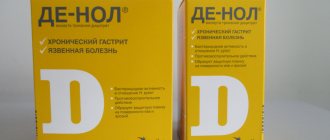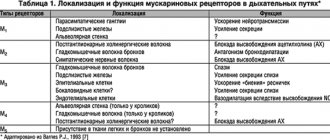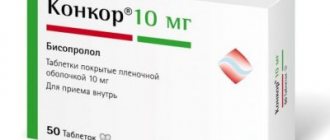Antacids
Antacids
(from Greek ἀντἰ- - against, Latin
acidus
- sour) - medications whose mechanism of action is based on the chemical neutralization of gastric acid.
Composition of antacids
The main acid-neutralizing active ingredients of modern antacids are magnesium, aluminum and calcium compounds.
Many of the modern antacid drugs, in addition, contain components that affect the gastrointestinal tract in a way other than neutralizing the acid: laxatives, carminatives, antispasmodics, anesthetics and others. Most modern antacid preparations use a balanced combination of magnesium compounds (magnesium oxide, magnesium hydroxide, magnesium peroxide, magnesium carbonate) and aluminum (aluminum hydroxide, aluminum phosphate and others). Such antacid drugs are characterized by a slower onset of therapeutic effect compared to sodium and calcium compounds, but they have a longer effect time. Such compounds do not dissolve in water, are practically not absorbed into the blood, are characterized by antipeptic properties and partially adsorb toxins. Aluminum compounds help slow intestinal motility and in large quantities can cause constipation, while magnesium compounds accelerate intestinal motility and have a laxative effect. Aluminum compounds enhance the synthesis of prostaglandins, promote the formation of a protective film on the surface of damaged tissues, adsorb bile acids and lysolecithin, and increase the tone of the lower esophageal sphincter. Magnesium compounds increase mucus formation and resistance of the gastric mucosa. The table below (Kharchenko N.V., Chernenko V.V.) shows the effects of the main components of modern antacid drugs (- no effect, + low activity, ++ medium activity, +++ high activity).
| Characteristics of some components of modern antacids | ||||
| Action/cations | Mg | Ca | Al | Bi |
| Neutralizing | +++ | + | ++/+++ | – |
| Adsorbent | + | + | +++ | + |
| Enveloping | – | – | + | – |
| Astringent | – | – | + | +++ |
| Cytoprotective | – | – | +++ | + |
Absorbable antacids
Absorbed antacids are those that either themselves or the products of their reaction with gastric acid dissolve in the blood. A positive quality of absorbed antacids is the rapid decrease in acidity after taking the medicine. Negative - short duration of action, acid rebound (increased secretion of hydrochloric acid after the end of the drug), the formation of carbon dioxide during their reaction with hydrochloric acid, stretching the stomach and stimulating gastroesophageal reflux (see figure from the article by D.S. Bordin, below and on the right)
. Absorption of bicarbonates into the blood can lead to the development of systemic alkalosis. Long-term use of calcium-containing absorbable antacids can cause constipation and hypercalcemia, and in combination with milk or dairy products - milk-alkali syndrome, manifested by nausea, vomiting, polyuria, transient azotemia. The development of calcium kidney stones and nephrocalcinosis is possible.
Examples of absorbable antacids:
- sodium bicarbonate (baking soda)
- calcium carbonate
- magnesium carbonate basic
- magnesium oxide
- Bourget mixture (a mixture of sodium bicarbonate, sulfate and sodium phosphate)
- medicines "Rennie", "Tums", "Andrews Antacid" (a mixture of calcium carbonate and magnesium carbonate).
Non-absorbable antacids
The active components of non-absorbable antacids are aluminum hydroxide, aluminum phosphate, magnesium hydroxide, magnesium trisilicate.
Non-absorbable antacids begin to act later than absorbable ones, but their duration of action is longer and reaches 2.5–3 hours. They are buffered against hydrochloric acid of gastric juice and, due to this, maintain acidity during their period of action within the range of 3–4 pH. Non-absorbable antacids are divided into the following groups:
- with aluminum salt of phosphoric acid - aluminum phosphate (preparations based on them: Alfogel, Gasterin, Phosphalugel)
- aluminum-magnesium combinations, the most common of which is “algeldrate + magnesium hydroxide” (antacid preparations: “Almagel”, “Altacid”, “Alumag”, “Gastratsid”, “Maalox”, “Maalukol” and “Palmagel”)
- aluminum-magnesium-silicon or sodium-calcium combinations with the addition of alginate (antacid drugs: Topalcan, Gaviscon)
- aluminum-magnesium combinations with the addition of the anesthetic benzocaine (antacid preparations: Almagel A, Palmagel A)
- aluminum-magnesium preparations with the addition of simethicone, used to prevent flatulence (antacid preparations: Almagel Neo, Antareit, Gestid, Relzer)
- combinations of aluminum, magnesium and calcium compounds: hydrotalcite (antacid preparations: “Renni-Tal”, “Rutacid”, “Taltsid”, “Tisacid”), hydrotalcite and magnesium hydroxide (“Gastal”) and others
Comparison of the effects of various antacids
At the Central Research Institute of Gastroenterology, using intragastric pH-metry,
studies were carried out on the acid-neutralizing effect of various antacids. Table 2 (see below) presents average data for some drugs: the time of onset of action of the antacid from the moment of taking the drug, the time of action of the antacid drug, the area of alkalization (corresponding to the volume of acid neutralized by the antacid) and the alkalization index, equal to the area of alkalization divided by the acidity of the stomach juice at the time the drug begins to act.
| Indicators | A drug | ||||
| Almagel | Remagel | Phosphalugel | Megalac | Maalox | |
| Action onset time, min | 13,5 | – | – | – | 8,9 |
| Action time, min | 28 | 32,5 | 40 | 46 | 56 |
| Alkalinization area | 6,6 | 4,5 | 5,4 | 6,5 | 13,2 |
| Alkalinity index | 9,0 | 11,4 | 6,7 | 13,5 | 18,0 |
The time for the onset of antacid action after administration was the shortest for Maalox (an average of 8.9 minutes), the longest for Almagel (an average of 13.5 minutes). The average duration of the alkalizing effect of antacids also varied widely, from 28 minutes for Almagel to 56 minutes for Maalox. At the same time, Remagel, Phosphalugel and Megalac occupied an intermediate position between them. Analysis of pH grams showed that the maximum acidity values after taking various antacids differed slightly. However, the indicators of the severity of the alkalizing effect—the time to reach maximum pH values and the duration of “retention” of the maximum effect—were most optimal for Maalox (Ilchenko A.A., Selezneva E.Ya.).
Dosage forms of antacids
The most common forms of release of antacid drugs are: tablets, lozenges, oral suspension in a bottle, oral suspension in sachets containing a single dose of the drug.
The release form is important for the neutralizing ability of the antacid, as well as for its convenience for use by patients. Antacids interact with hydrogen ions only in a dissolved state, so solubility is an important parameter affecting the effectiveness of antacids. Suspensions are made up of smaller particles than tablets, so they have a larger surface area and dissolve faster in the stomach. Pre-chewed and dissolved tablets are more effective than tablets swallowed whole. However, taking the suspension is not always convenient for patients who lead an active lifestyle, so some of them take the suspension at home and tablets in public places.
The use of antacids for heartburn and the treatment of gastroesophageal reflux disease
Antacids can be used both as monotherapy for rare heartburn, which is not accompanied by the development of esophagitis, and in complex treatment regimens for gastroesophageal reflux disease (GERD), as they are effective in quickly eliminating symptoms.
Aluminum phosphate 2.08 g, combination preparations - magaldrate 400 or 800 mg and simethicone 20 or 40 mg, aluminum hydroxide 400 mg and magnesium hydroxide 400 mg are used in the treatment of moderate and infrequently occurring symptoms, especially those associated with non-compliance with the recommended lifestyle life. A combined drug containing magaldrate and simethicone is able to quickly neutralize hydrochloric acid and maintain a stable pH level for a long time, and very actively bind bile salts. With its use, symptoms disappear in most patients with GERD.
Antacids should be taken depending on the severity of symptoms, usually after meals and at night until the symptoms of the disease are persistently relieved, then “as required.” There is insufficient data indicating the possibility of their constant use (Recommendations of the Russian State Administration for the diagnosis and treatment of GERD, 2020).
Antacids in the treatment of duodenal ulcers
Modern medical science absolutely rightly believes that the main drugs used in the treatment of acid-dependent diseases should be drugs that most effectively inhibit gastric acid production, which today are proton pump inhibitors. Taking any antacids and adsorbents during Helicobacter pylori
is undesirable due to a possible decrease in the effectiveness of antibacterial treatment. Antacids, having given way to proton pump inhibitors and other antisecretory drugs in suppressing gastric acidity, occupy a significant niche in the treatment of acid-dependent conditions.
For example, a modern non-absorbable antacid based on the aluminum-magnesium combination “aluminum hydroxide + magnesium hydroxide” (for example, “Almagel”, “Altacid”, “Alumag”, “Gastratsid”, “Maalox”, “Maalukol”, “Palmagel” and similar) can be used in the treatment of duodenal ulcers in the following situations (Maev I.V., Samsonov A.A., Minushkin O.N.):
- for pain relief during the screening phase, as well as on the first day of taking proton pump inhibitors before the start of blockade of acid production
- with small ulcer sizes (no more than 1.0 cm) and a short history of ulcers, in the absence of Helicobacter pylori
, aluminum-magnesium antacids can be prescribed as the only drug. - for ulcers larger than 1.0 cm, for long-term non-healing ulcers, such antacids are used in combination with proton pump inhibitors in order to enhance the cytoprotective effect (growth factor fixation phenomenon) - for ulcers not associated with Helicobacter pylori
, as well as for associated ones, in cases with difficult to scar ulcers - in the case of the use of histamine H2-blockers and their withdrawal, to level out a possible “acid rebound”
- after eradication of Helicobacter pylori
to relieve possible episodic pain and heartburn - as anti-relapse therapy
The use of antacids in the treatment of chronic duodenitis
Antacids in the treatment of chronic duodenitis are used in the following situations (Maev I.V., Samsonov A.A.):
- as an additional antisecretory agent to H2 blockers or proton pump inhibitors, as an additional adsorbent agent in the treatment of acute gastroduodenitis or acute duodenitis
- as an additional antisecretory agent during therapy with H2 blockers or proton pump inhibitors during exacerbation of chronic gastroduodenitis or chronic duodenitis, including against the background of celiac disease, gastric and duodenal ulcers, liver or pancreas diseases
- at the end of eradication of Helicobacter pylori
in peptic ulcer with symptoms of secondary duodenitis, to reduce pain and dyspeptic symptoms (pain or discomfort, heaviness, fullness, early saturation, localized in the epigastric region) in the period until the final scarring of the ulcerative defect and the subsidence of the phenomena of secondary inflammation - in order to prevent relapses of chronic duodenitis
- to prevent the occurrence of gastro- and duodenopathy while taking NSAIDs, either alone or in combination with antisecretory drugs;
- to level out a possible “acid rebound” after completion of H2-blocker therapy
Publications for healthcare professionals regarding antacids
- Ivashkin V.T., Maev I.V., Trukhmanov A.S., Lapina T.L., Storonova O.A., Zayratiants O.V., Dronova O.B., Kucheryavyi Yu.A., Pirogov S. S.S., Sayfutdinov R.G., Uspensky Yu.P., Sheptulin A.A., Andreev D.N., Rumyantseva D.E. Recommendations of the Russian Gastroenterological Association for the diagnosis and treatment of gastroesophageal reflux disease. Russian Journal of Gastroenterology, Hepatology, Coloproctology. 2020;30(4):70–97.
- Maev I.V., Vyuchnova E.S., Dicheva D.T. and others. Gastroesophageal reflux disease (educational manual). - M.: VUNTSMZ RF, - 2000.
- Belmer S.V., Gasilina T.V., Kovalenko A.A. Methods for assessing the individual effectiveness of antacid and antisecretory drugs in pediatric gastroenterology (work experience). - M.: RGMU. – 2001. – 32 p.
- Ilchenko A.A., Selezneva E.Ya. Computer pH-metry of the stomach and esophagus. Clinical significance of the method: Methodological recommendations No. 15.-M.: Department of Health of the Moscow Government. – 2001. – 40 p.
- Ivashkin V.T., Baranskaya E.K., Shifrin O.S. and others. The place of antacids in modern therapy of peptic ulcer // Russian Medical Journal. Diseases of the digestive system. – 2002. – T.4. – No. 2.
- Ermolova T.V., Shabrov A.V., Kasherininova I.I., Ermolova S.Yu. The role of modern antacids in gastroenterological practice // Practical Medicine. – 2003. – No. 4. – p. 46–47.
- Vasiliev Yu.V. Enveloping (antacid) drugs in the treatment of certain diseases of the upper digestive tract. Russian Medical Journal. - 2004. - Volume 12. - No. 5.
- Maev I.V., Samsonov A.A. The use of modern antacids in the treatment of acid-dependent diseases of the gastrointestinal tract // Handbook of a polyclinic doctor. – 2005. – No. 5.
- Ushkalova E.A. Clinical pharmacology of modern antacids // Farmateka. – 2006. – No. 11. – p.1–6.
- Bordin D.S. Advantages of non-absorbable antacids // Attending Physician. – 2010. – No. 8.
- Minushkin O.N., Elizavetina G.A. Antacids in modern therapy of acid-dependent diseases // Gastroenterology of St. Petersburg. - 2010. - No. 2-3. - With. 9-12.
- Kolesnikova I.Yu., Volkov V.S. Diagnosis and treatment of acid-related diseases of the digestive tract. Guide for doctors / M.: Publishing House “Medical Information Agency”, 2014. - 432 p.
On the website GastroScan.ru in the “Literature” section there is a subsection “Antacids”, containing publications concerning the use of antacids.
Video for doctors
Still from video Vovk E.I. Medicines for the treatment of heartburn and diseases associated with hyperacidity. Clinical pharmacology
Video for medical university students
Frame “Indications for the use of antacids” from a video lecture for 3rd year students of the Faculty of Medicine of PSPbSMU named after. acad. I.P. Pavlova: Melnikov K.N. Drugs affecting the gastrointestinal tract
On the website GastroScan.ru in the “Video” section there is a subsection for patients “Popular Gastroenterology” and subsections “For doctors” and “For medical students and residents”, containing video recordings of reports, lectures, webinars in various areas of gastroenterology for healthcare professionals and students medicine.
Group of antacids in classifiers
In the International Anatomical Therapeutic Chemical Classification, the subsection Drugs for the treatment of diseases associated with acidity disorders includes the group “Antacids, code A02A”, which has eight subgroups:
- A02AA Magnesium preparations
- A02AB Aluminum preparations
- A02AC Calcium preparations
- A02AD Combination of aluminum, calcium and magnesium preparations
- A02AF Antacids in combination with carminatives
- A02AG Antacids in combination with antispasmodics
- A02AH Antacids in combination with sodium bicarbonate
- A02AX Antacids in combination with other drugs
In the Pharmacological Index, in the section Gastrointestinal Drugs, there is a group “Antacids and Adsorbents”.
Antacids have contraindications and features of use; before starting use, consultation with a specialist is necessary.
Back to section
When there is increased acidity in the stomach
The acidity of gastric juice increases in various pathological processes of the gastrointestinal tract
The stomach is a complex organ that consists of cells with different purposes, and also has its own nervous regulation and blood supply. When all these components interact harmoniously, then no problems with digestion arise. But problems at different levels of gastric organization ultimately lead to the same symptoms.
Only a qualified specialist can tell where the “breakdown” occurred. Hence the recommended prescription of drugs. To treat high acidity, it is necessary to prescribe a drug aimed at the cause of high acidity.
Indications for use
Antacids are prescribed for so-called acid-dependent diseases, in which hydrochloric acid causes irritation or ulceration of the mucous membrane of the stomach, duodenum or esophagus. In this case, inflammation of the gastric mucosa is called gastritis, inflammation of the duodenum is gastroduodenitis, and inflammation of the esophageal mucosa is called esophagitis. If the damage to the gastric mucosa is deep enough, then they speak of a gastric ulcer.
The cause of this type of disease is not completely known. It is believed that the key factors that provoke these diseases are malnutrition, an excess of spicy, fatty and fried foods in the diet, psycho-emotional stress, genetic predisposition and bad habits such as alcohol and smoking.
The main symptom for which antacids are prescribed is heartburn - an unpleasant burning sensation in the upper abdomen or behind the sternum. In this case, the acidic contents of the stomach are refluxed into the esophagus. This phenomenon is called gastroesophageal reflux. This symptom appears most often after eating a large meal, fried, fatty, salty, spicy, tomatoes, and in cases of taking a horizontal position of the body immediately after eating. In addition, heartburn can occur when intraperitoneal pressure increases, for example, during pregnancy or obesity.
Basics of symptomatic treatment of heartburn
If heartburn occurs, it is first recommended to pay attention to lifestyle and nutrition. It is not recommended to take a horizontal body position for at least 1 hour after eating. Eliminate hot, spicy and excessively fatty and salty foods from your diet. Limit consumption of tomatoes, coffee, tea and alcohol.
Prescribe antacids after meals if heartburn symptoms occur. If pain in the stomach area occurs, accompanied by heartburn, you should consult a doctor.
Contraindications
Only non-absorbable antacids have contraindications, and there are few of them.
| Absolute | Relative |
|
|
Side effects
Absorbable antacids have virtually no side effects, except for allergic reactions that occur in case of overdose. After stopping the medication or significantly reducing the dose, these reactions stop.
The undesirable effects of non-absorbable drugs are extensive:
- constipation at high doses;
- nausea and vomiting (rare);
- change in the taste of food;
- a significant increase in serum magnesium levels, which, combined with a lack of phosphorus from food, can lead to softening of the bones (osteomalacia).
Such effects occur only with prolonged uncontrolled use in high doses. If you follow the dosage indicated in the instructions or are under the supervision of a doctor, then side effects can be avoided.
Comparative characteristics of the main components
Most often, antacids contain Magnesium, Calcium and Aluminum salts. The table below shows the differences and features of their action, as well as a comparison with Bismuth preparations (for example, De-Nol).
| Effect /Salt | Magnesium | Calcium | Aluminum | Bismuth preparations |
| Neutralization of hydrochloric acid | Expressed | Moderate | Moderate | Absent |
| Adsorption of substances | Minor | Minor | Expressed | Minor |
| Enveloping the walls of the stomach | Absent | Absent | Minor | Absent |
| Astringent action | Absent | Absent | Minor | Expressed |
| Cytoprotection of the mucous membrane | Absent | Absent | Expressed | Minor |
Most modern drugs are a combination of various salts , which allows you to combine their strengths.
Features of application
When using antacids, it should be remembered that in case of gastric ulcer, sodium bicarbonate is contraindicated and calcium and magnesium carbonates are not recommended. Drugs belonging to the group of absorbable antacids should be taken only when heartburn symptoms occur. They should not be taken for prophylactic purposes.
When using non-absorbable antacids, especially gel forms, it should be remembered that they can interfere with the absorption of other drugs, and the gap in taking, for example, aluminum phosphate gel, with other drugs should be at least three hours.
If heartburn occurs at night, it is better to use non-absorbable antacids. As already noted, they last longer. In this case, they should be used an hour after meals.
Foods and drinks that affect stomach acidity
Since high acidity is characteristic of the stomach, the purpose of which is to digest food, you need to think about which foods and liquids should be taken, and which ones should be avoided or better removed from the diet altogether.
If a person has an exacerbation, then it is necessary to change the diet for some time, and if the increased acidity is permanent, then this is the way to follow a diet all the time.
What to give up
Prohibited Products
However, there are general nutritional rules for people with high acidity:
- It is necessary to remove any products that increase the acidity of the stomach - coffee and strong tea, as these drinks contain caffeine. And caffeine is a substance that increases acidity.
- You should avoid alcohol, as the ethanol in its composition causes an irritant effect on the stomach, which causes a reflex increase in acidity.
- If you have heartburn, it is better to avoid any juices, especially freshly squeezed ones, since fruits and vegetables contain fruit acids, which are a provoking factor for the release of hydrochloric acid in the stomach.
- In this regard, it is worth giving up unprocessed fruits and vegetables. Since they contain not only fruit acids, but also coarse dietary fiber, which will put a lot of strain on an already irritated stomach.
You might think that the list is too demanding, but this is not surprising, because the stomach reacts to everything that gets into it - this is the purpose of the stomach - to process what gets into it.
But there is a difference, the stomach reacts to foods differently - to some more strongly, these foods are listed above. And some less. A person’s task is to eat foods with the most neutral effect on the stomach.
What can you eat if you have high stomach acidity?
It is recommended to eat cereals, low-fat soups, mashed potatoes
If a person has a high stage of exacerbation, then he should limit himself to well-cooked porridges, such as semolina and oatmeal, without added sugar, but doctors allow porridge with milk and dried bread.
If the exacerbation is not very severe, then you can eat low-fat foods, without spices, for example, mashed potatoes, light soups, lean chicken and fish. In a word, such a menu can be called dietary.
What medications are suitable during pregnancy
Pregnant women often complain of increased stomach acidity
Everything related to pregnancy and pregnant women is always a sensitive issue, especially in relation to any substances. Any medications must be prescribed by a doctor. And the usual reason for prescribing a drug is if the risk to the mother's health from the disease outweighs the harm the drug could cause to the fetus. Therefore, they try to solve the situation with high acidity by adjusting the diet.
However, your doctor may prescribe enzyme preparations, which are usually a biological product rather than a chemical compound.






